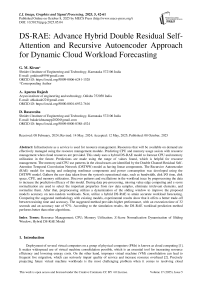DS-RAE: Advance Hybrid Double Residual Self-Attention and Recursive Autoencoder Approach for Dynamic Cloud Workload Forecasting
Автор: G.M. Kiran, A. Aparna Rajesh, D. Basavesha
Журнал: International Journal of Image, Graphics and Signal Processing @ijigsp
Статья в выпуске: 5 vol.17, 2025 года.
Бесплатный доступ
Infrastructure as a service is used for resource management. Resources that will be available on demand are effectively managed using the resource management module. Predicting CPU and memory usage assists with resource management when cloud resources are provided. This study uses a hybrid DS-RAE model to forecast CPU and memory utilization in the future. Predictions are made using the range of values found, which is helpful for resource management. The memory and CPU use patterns in the cloud traces are identified by the Double Channel Residual Self-Attention Temporal Convolution Network (DSTNW) model as having linear components. The Recursive Autoencoder (RAE) model for tracing and enlarging nonlinear components and power consumption was developed using the DSTNW model. Gathers the raw data taken from the system's operational state, such as bandwidth, disk I/O time, disk space, CPU, and memory utilization. Discover patterns and oscillations in the workload trace by preprocessing the data to increase the prediction efficacy of this model. During data pre-processing, missing value edge computing and z-score normalization are used to select the important properties from raw data samples, eliminate irrelevant elements, and normalize them. After that, preprocessing utilizes a dynamization of the sliding window to improve the proposed model's accuracy on non-random workloads. Next, utilize a hybrid DS-RAE to attain accurate workload forecasting. Comparing the suggested methodology with existing models, experimental results show that it offers a better trade-off between training time and accuracy. The suggested method provides higher performance, with an execution time of 32 seconds and an accuracy rate of 97%. According to the simulation results, the DS-RAE workload prediction method performs better than other algorithms.
Resource Management, CPU, Memory Utilization, Z-Score Normalization Dynamization of Sliding Window, Hybrid DS-RAE Model
Короткий адрес: https://sciup.org/15019979
IDR: 15019979 | DOI: 10.5815/ijigsp.2025.05.04


